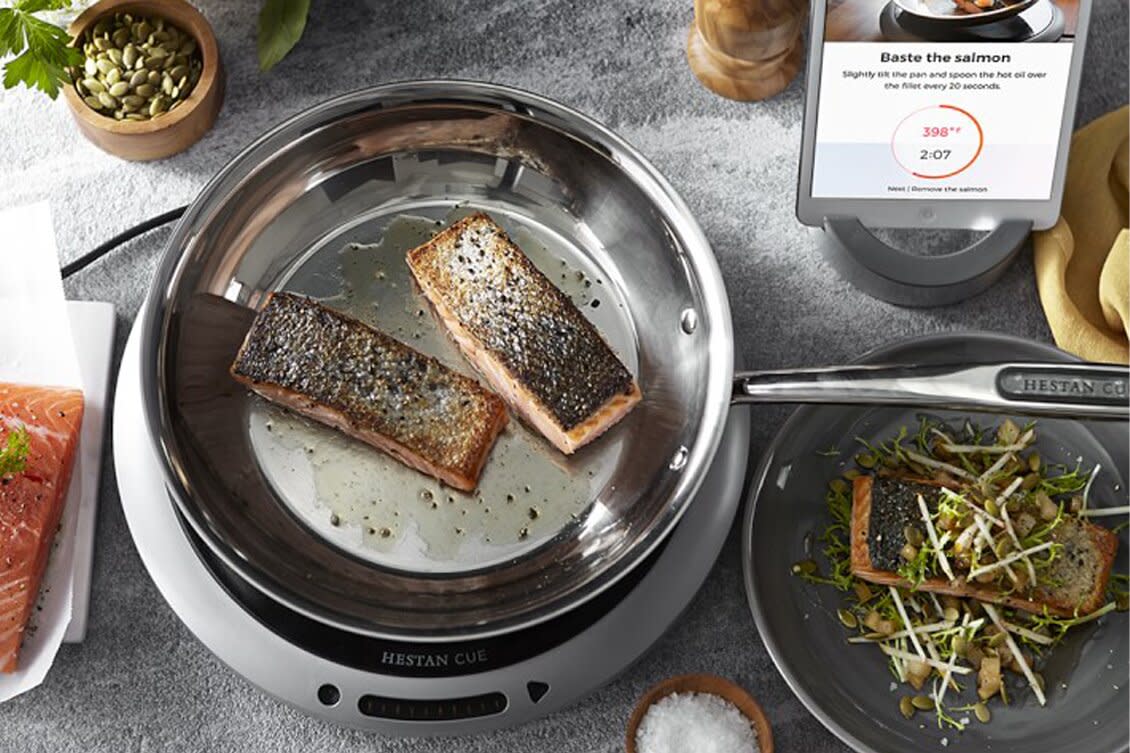The Pros and Cons of Induction Cooking

Courtesy of Williams-Sonoma
Induction cooking may very well be the future. It has long been popular in Europe, especially in professional kitchens. Since 2019, regulations to restrict or ban gas stoves and other gas appliances in California have been increasing due to concerns about climate change—and the state has recently adopted new building codes that ban natural gas in new homes and support all electric construction.
In other areas of the country, there are also incentives and rebates for going electric. Despite opposition from the fossil fuel industry, it's likely the move away from gas will continue and expand—along with it, we'll likely see a transition from gas to induction cooking at home. That's a lot to take in, and you're probably wondering how induction cooking works (and if it might it be right for your kitchen).
Related: 5 Best Portable Induction Cooktops
What Is Induction Cooking?
Induction is electromagnetic and involves using magnets to excite metallic pans and create heat. Pans essentially become burners, eliminating heat transfer through a glass cooktop surface—this is different from regular electric cooking and is more efficient and safer. Induction cooking is available in a single "burner" or heating zone, a cooktop with multiple heating zones, or via a range.
Cookware Compatibility
Because electromagnetic waves are used to cook and produce heat, induction cooking requires magnetic cookware. If a magnet sticks to a pan, it can be used with an induction cooktop. Cookware that is magnetic, and therefore compatible, includes cast iron, enameled cast iron, and stainless steel. Fully clad cookware brands, such as All Clad and Le Creuset, have pans that will work.
Pros of Induction Cooking
Many food experts are enthusiastic proponents of induction cooking—including Rachelle Boucher, executive chef, electric kitchens expert, and founder of Kitchens to Life. She points to several advantages over cooking with gas.
Air Quality
Put simply, induction cooking is better for the environment. "Natural gas creates unacceptable amounts of pollution with methane and particulate matter in the air," says Boucher. "With induction, there's less need for air conditioning and ventilation."
Safety
In addition to a decrease in air pollution, this cooking style is also safer than gas, since induction cooking is flameless. With no flame, there is no fire, so you're decreasing the likelihood of kitchen fires and burns.
Energy Efficiency
Induction stoves and cooktops are more powerful, but also more energy efficient than electric or gas since heat isn't lost in the transferring process. With gas and electric ranges, a lot of energy is lost to the air around the pots and pans. With induction, only the cookware heats.
Heats Faster and Is More Precise
The main reason Boucher prefers cooking with induction is that it's faster and more precise. Not only does it heat two to three times more quickly than gas—with induction, you don't have to wait for the heating element to transfer to the pan because the pan heats up directly. "You can [also] choose a specific temperature and it's more consistent," she says. Plus, When you turn the burner off, the heat transfer stops immediately, which means less of a chance of foods boiling over or overcooking.
Easier to Clean
Cleaning up is also much faster and easier with induction, because only the pan is heating. The smooth glass top stays cool, so drips and splatters don't stick and burn. Because the unused surface stays cool and is smooth, the cooktop effectively becomes additional counter space for cooking utensils, cookbooks, and other items you might not safely be able to place on a hot surface.
Related: How to Clean Stove Burners (and the Rest of Your Stovetop)
Cons of Induction Cooking
There are, however, a few disadvantages to induction, including price, the learning curve, and potentiality for damage.
Purchase Price
The prices for induction have come down, but this cooking method is still a more expensive investment than low-end gas appliances. Additionally, there may be an added expense if you need to invest in new cookware. Non-magnetic cookware, such as copper, glass, aluminum, and ceramic, would not be incompatible with induction unless they have a layer of magnetic material. And if your favorite wok has a round bottom, you can't just add a ring to your cooktop—you'll need either a flat bottom wok or a special induction wok hob.
Education
There's a learning curve that comes with adjusting to any new way of cooking, including induction, says Boucher. While induction's speed is an advantage, it requires a rhythm and pace of cooking that differs from gas or electric. A home cook may initially be confused by the appliance's disappearing touchscreens—or have a tough time adjusting to the speed and getting used to the fact that when pans are removed from the cooktop, it turns off. This is a disadvantage initially, but some appliance companies provide loaners and the opportunity to "try before you buy" in a showroom kitchen.
Scratches
While Boucher has not experienced this, she says because induction cooktops are glass, there is a possibility they can scratch or break.
